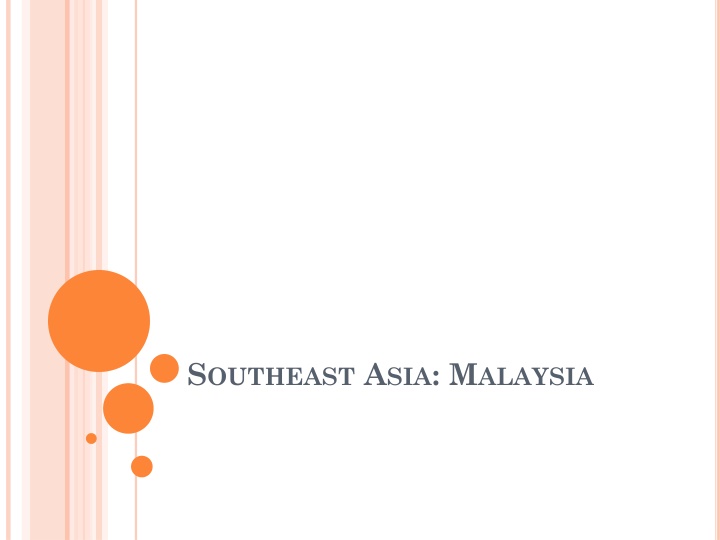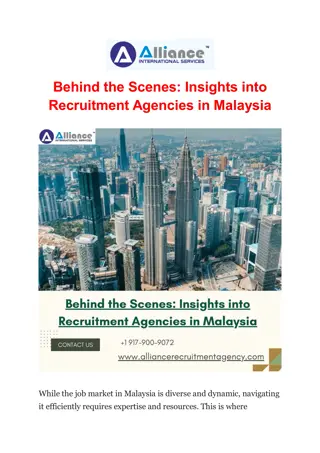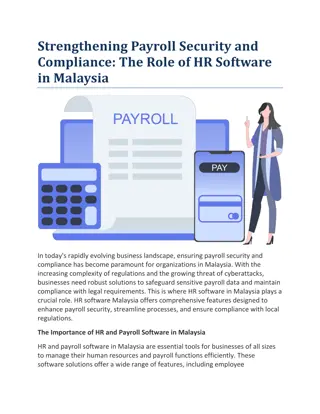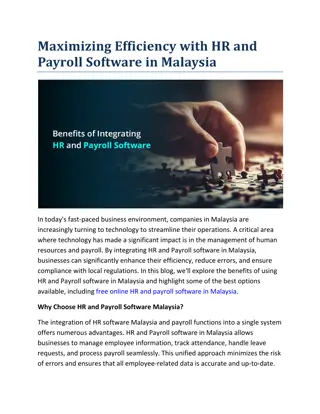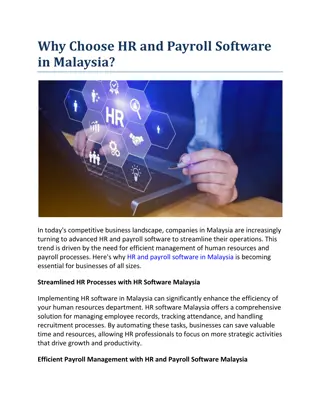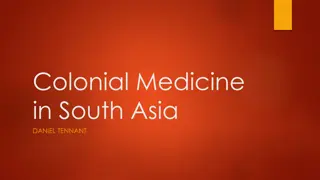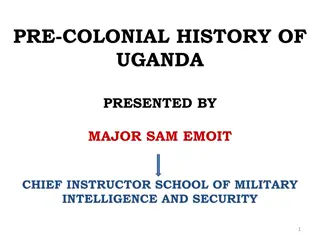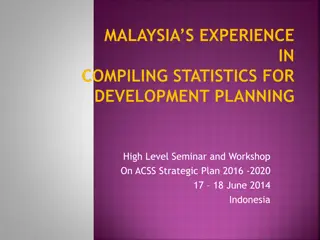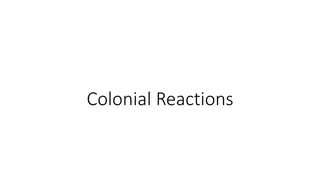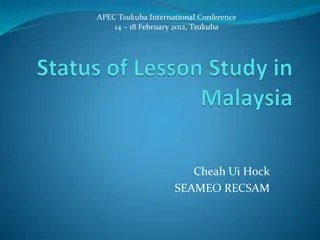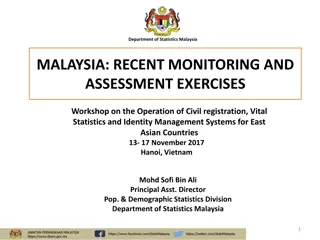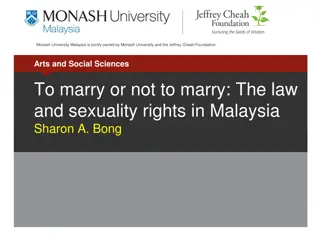History of Malaysia: From Pre-history to Colonial Rule
Malaysian history traces back to the migration of Proto-Malays from China, development of trade ports, adoption of Buddhism, Hinduism, and Islam, the rise of the Malacca Sultanate, and European colonial rule by Portugal and the Dutch. The region's rich history is marked by cultural exchanges, trade dominance, and the arrival of diverse populations.
Download Presentation

Please find below an Image/Link to download the presentation.
The content on the website is provided AS IS for your information and personal use only. It may not be sold, licensed, or shared on other websites without obtaining consent from the author.If you encounter any issues during the download, it is possible that the publisher has removed the file from their server.
You are allowed to download the files provided on this website for personal or commercial use, subject to the condition that they are used lawfully. All files are the property of their respective owners.
The content on the website is provided AS IS for your information and personal use only. It may not be sold, licensed, or shared on other websites without obtaining consent from the author.
E N D
Presentation Transcript
PRE-HISTORY 10,000 years ago Anthropologists believe aboriginal Proto-Malays migrated from southwest China, eventually traveling to Indonesia, Sumatra and Borneo. Proto-Malays have been found to be ethnically related to people in Sumatra, Java and parts of the Philippines. 300 BC Arrival of Deutero-Malays, descended partly from Cham people of the Mekong Delta. They push the Proto-Malays into the north and become direct ancestors of today s ethnic Malays. 100 BC Commerce begins with China and India, establishing ports in Malaysia along essential trade routes and bringing foreign influence.
PRE-HISTORY 0-400 AD Buddhism and Hinduism arrive from India and are adopted; Sanksrit becomes the writing system. 600-1200 AD Much of Malay peninsula ruled by maharajas of the trade-based Srivijaya empire, which enhances the area s vital role in regional trade. Srijijaya Empire: controlled the seas bordering Southeast Asia from AD 600 1300. Controlled the Strait of Malacca and Sunda Strait, used heavily for ancient trade routes, and taxed traders who passed through.
PRE-HISTORY 1200-1300 Islam is gradually introduced by Arab and Indian traders, and is first adopted by the Malay elite. Early 1400s Port of Malacca founded by renegade prince Iskander Shah, purported to be a descendent of Alexander the Great, and who soon converts to Islam. According to a popular legend, Parameswara was resting under a tree near a river during a hunt, when one of his dogs cornered a mouse deer. In self-defence, the mouse deer pushed the dog into the river. Impressed by the courage of the deer, and taking it as a propitious omen of the weak overcoming the powerful, Parameswara decided then and there to found an empire on that very spot. He named it 'Melaka' after the tree where he had just taken shelter at, the Melaka tree. 1405 Visiting Chinese admiral offers to protect Malacca against invading Siamese; support allows Malacca to expand influence over much of peninsula. Malacca and other Malaysian sultanates dominates China-India sea trade over next 100 years as Mongol armies close land route to the West; Malay becomes official language and Malacca becomes important Islamic center.
COLONIAL RULE 1511 Portugal makes first European colonial claim on Malaysia, capturing Malacca. 1641 Dutch East India Company and local allies push Portuguese from Malacca. Dutch East India Company: was a chartered company established in 1602, when the States General of the Netherlands granted it a 21-year monopoly to carry out colonial activities in Asia. It is often considered to have been the first multinational corporation in the world and it was the first company to issue stock. It was also arguably the first megacorporation, possessing quasi- governmental powers, including the ability to wage war, imprison and execute convicts, negotiate treaties, coin money, and establish colonies. 1700s Now known as Malaya, its trading ports gain more economic clout as British trade with China expands. Mining of tin and gold brings influx of Arab, Indian and Chinese immigrants who soon control business.
COLONIAL RULE Late 1700s-1800s Britain establishes colonies and trading ports on Malay peninsula; Penang is leased to the British East India Company. 1824 Anglo-Dutch Treaty sets boundaries between British Malaya and the Netherlands East Indies, which is present- day Indonesia. 1857 Modern-day Kuala Lumpur is founded as a trading post for immigrant miners, and becomes capital of Federated Malay States in 1896. Late 1800s to 1941 Profits pour in due to wartime demand for tin and rubber; Britain builds strong naval presence to counter Japanese expansion.
WORLD WAR II (AND BEYOND) 1941 Japan bombs Singapore and Kota Bharu in Kelatan. Unprepared and outmanned for a land assault, British forces are routed and Singapore falls in February 1942. 1942 to 1945 During Japanese occupation, exports are stripped, nationalism grows, and ethnic tensions between Malays, Chinese and Indians are exacerbated. Japan s so-called sook ching (purification through suffering) campaign leads to the death of 80,000 ethnic Chinese in Malaya and Singapore. 1945 After US drops atomic bombs on Hiroshima and Nagasaki, British forces regain control of Malaya. 1946 United Malays National Organisation (UMNO) is founded by Onn bin Jaafar, chief minister of Johore. The nationalist group seeks independence from Britain, but will only tolerate a state dominated by ethnic Malays. 1948-1960 Influenced by Cold War politics, ethnic Chinese communist guerrillas maintain insurgency in jungle areas. Known as the Malayan Emergency, the uprising is eventually suppressed by British and Commonwealth forces. 1957 Federation of Malaya becomes independent from Britain. 1963 British colonies of Sabah, Sarawak and Singapore join Federation of Malaya to form the Federation of Malaysia. 1965 Singapore is expelled from Malaysia over political and racial concerns.
WORKS CITED http://www.aljazeera.com/indepth/spotlight/mala ysiaelections/2013/04/201342882836970501.html http://en.wikipedia.org/wiki/History_of_Malaysia
